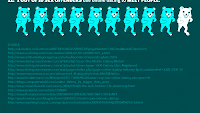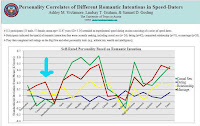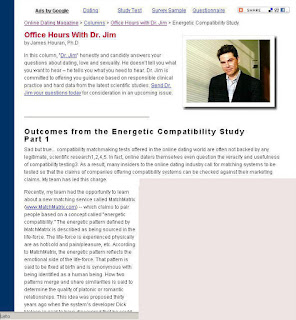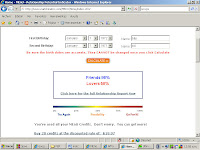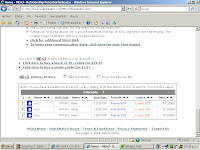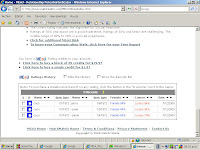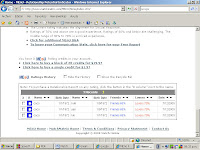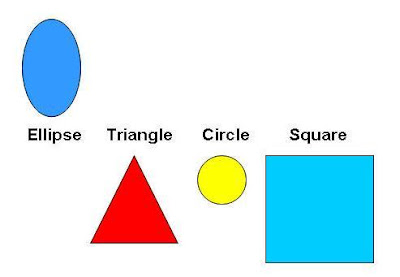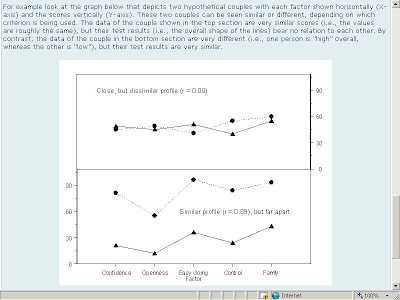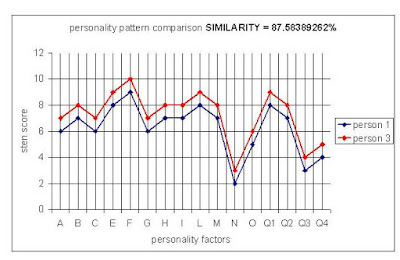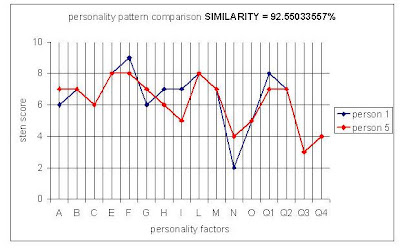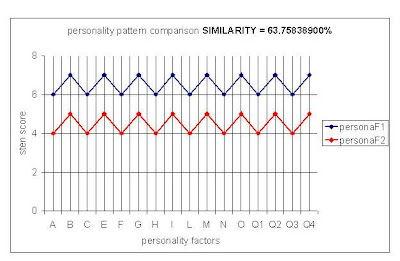Here is how
LIFEPROJECT METHOD calculates similarity between quantized patterns.
From the paper "METHODOLOGICAL AND DATA ANALYTIC ADVANCES IN THE STUDY OF INTERPERSONAL RELATIONSHIPS: INTRODUCTION TO THE SPECIAL ISSUE"
http://www.blackwell-synergy.com/doi/abs/10.1111/j.1475-6811.1999.tb00200.x
At page 413 says: "It is vital for the study of personal relationships, as for any scientific discipline, to develop methodologies that are specifically designed to address the questions posed by the discipline. The articles in this special issue represent an effort in that direction. Perhaps equally important is the need for individuals who are involved in relationships study to learn these new techniques and to apply them in their research. It is also important for investigators to challenge statisticians
to create new analytic techniques when existing ones are inadequate. These tasks are left to you, the reader."
That is because I had invented a new quantitative method to assess similarity.
Here is explained but without divulging proprietary information.
In compatibility matching methods there are 2 steps:
1) to measure personality traits or other variables.
2) to calculate compatibility between prospective mates.The
output of the 16PF5 test are 16 independent variables STens (Standard Tens) taking integer values from 1 to 10. STens divide the score scale into ten units.
STens have the advantage that they enable
results to be thought of in terms of bands of scores, rather than absolute raw scores.
These bands are narrow enough to distinguish statistically significant differences between candidates, but wide enough not to over emphasize minor differences between candidates.
Similarity is a word that has different meanings for different persons or companies, it exactly depends on how mathematically is defined.
I calculate similarity in personality patterns with (a proprietary) pattern recognition by correlation method. It takes into account the score and the trend to score of any pattern.
Dyadic comparison between person #X and person #Y is given from the following formula, derived / adapted from an advanced math equation
The BRA (#X/ means client #X's 16PF5 Report
The KET /#Y) means client #Y's 16PF5 Report
/CQ/ means Comparison Operator
(#X/CQ/#Y) means the Comparison between client #X and client #Y
(#X/CQ/#Y) == K01(AX/CQ/AY) + K02(BX/CQ/BY) + K03(CX/CQ/CY) + K04(EX/CQ/EY) + K05(FX/CQ/FY) + K06(GX/CQ/GY) + K07(HX/CQ/HY) + K08(IX/CQ/IY) + K09(LX/CQ/LY) + K10(MX/CQ/MY) + K11(NX/CQ/NY) + K12(OX/CQ/OY) + K13(Q1X/CQ/Q1Y) + K14(Q2X/CQ/Q2Y) + K15(Q3X/CQ/Q3Y) + K16(Q4X/CQ/Q4Y) == PROBABILITY OF BEING COMPATIBLE
(A) Warmth; (B) Reasoning; (C) Emotional Stability; (E) Dominance, (F) Liveliness; (G) RuleConsciousness; (H) Social Boldness; (I) Sensitivity; (L) Vigilance; (M) Abstractedness; (N) Privateness (O) Apprehension; (Q1) Openness to Change; (Q2) SelfReliance; (Q3) Perfectionism; (Q4) Tension. 16 independent variables that take integer values from 1 to 10
With K01 + K02 + K03 + K04 + K05 + K06 + K07 + K08 + K09 + K10 + K11 + K12 + K13 + K14 + K15 + K16 == 1 or 100%
K01 diff from K02 diff from K03 diff from K04 diff from K05 diff from K06 diff from K07 diff from K08 diff from K09 diff from K10 diff from K11 diff from K12 diff from K13 diff from K14 diff from K15 diff from K16 means not necessarily all the same
(A/CQ/B) == (A/CQ/C) == (A/CQ/E) == ..... == (A/CQ/Q4) == 0
(B/CQ/A) == (B/CQ/C) == (B/CQ/E) == ..... == (B/CQ/Q4) == 0
……………………………………………………………………………………………………
(Q4/CQ/A) == (Q4/CQ/B) == (Q4/CQ/C) == ..... == (Q4/CQ/Q3) == 0
and
(1/CQ/1)
(1/CQ/2) == (2/CQ/1)
(1/CQ/3) == (3/CQ/1)
(1/CQ/4) == (4/CQ/1)
(1/CQ/5) == (5/CQ/1)
(1/CQ/6) == (6/CQ/1)
(1/CQ/7) == (7/CQ/1)
(1/CQ/8) == (8/CQ/1)
(1/CQ/9) == (9/CQ/1)
(1/CQ/10) == (10/CQ/1)
(2/CQ/1) == (1/CQ/2)
(2/CQ/2)
(2/CQ/3) == (3/CQ/2)
(2/CQ/4) == (4/CQ/2)
(2/CQ/5) == (5/CQ/2)
(2/CQ/6) == (6/CQ/2)
(2/CQ/7) == (7/CQ/2)
(2/CQ/8) == (8/CQ/2)
(2/CQ/9) == (9/CQ/2)
(2/CQ/10) == (10/CQ/2)
………………………………………………
………………………………………………
(10/CQ/1) == (1/CQ/10)
(10/CQ/2) == (2/CQ/10)
(10/CQ/3) == (3/CQ/10)
(10/CQ/4) == (4/CQ/10)
(10/CQ/5) == (5/CQ/10)
(10/CQ/6) == (6/CQ/10)
(10/CQ/7) == (7/CQ/10)
(10/CQ/8) == (8/CQ/10)
(10/CQ/9) == (9/CQ/10)
(10/CQ/10)
(all real values of the complete base were derived by Fernando Ardenghi)
BRA (#X/ means person #X's 16PF5 Report
KET /#Y) means person #Y's 16PF5 Report
/CQ/ means Comparison Operator
For person #X:: A:6.B:7.C:6.E:8.F:9.G:6.H:7.I:7.L:8.M:7.N:2.O:5.Q1:8.Q2:7.Q3:3.Q4:4
16 distinguishable particles in a one_dimensional box of length L and infinite outside the box with 10 quantized levels of energy (named box X)
distinguishable particle (A) Warmth at level "6"
distinguishable particle (B) Reasoning at level "7"
distinguishable particle (C) Emotional Stability at level "6"
distinguishable particle (E) Dominance at level "8"
distinguishable particle (F) Liveliness at level "9"
distinguishable particle (G) RuleConsciousness at level "6"
distinguishable particle (H) Social Boldness at level "7"
distinguishable particle (I) Sensitivity at level "7"
distinguishable particle (L) Vigilance at level "8"
distinguishable particle (M) Abstractedness at level "7"
distinguishable particle (N) Privateness at level "2"
distinguishable particle (O) Apprehension to Change at level "5"
distinguishable particle (Q1) Openness at level "8"
distinguishable particle (Q2) SelfReliance at level "7"
distinguishable particle (Q3) Perfectionism at level "3"
distinguishable particle (Q4) Tension at level "4"
And
For person #Y:: A:5.B:7.C:4.E:8.F:7.G:4.H:5.I:6.L:4.M:6.N:8.O:9.Q1:6.Q2:8.Q3:4.Q4:4
16 distinguishable particles in other one_dimensional box of length L and infinite outside the box with 10 quantized levels of energy (named box Y)
distinguishable particle (A) Warmth at level "5"
distinguishable particle (B) Reasoning at level "7"
distinguishable particle (C) Emotional Stability at level "4"
distinguishable particle (E) Dominance at level "8"
distinguishable particle (F) Liveliness at level "7"
distinguishable particle (G) RuleConsciousness at level "4"
distinguishable particle (H) Social Boldness at level "5"
distinguishable particle (I) Sensitivity at level "6"
distinguishable particle (L) Vigilance at level "4"
distinguishable particle (M) Abstractedness at level "6"
distinguishable particle (N) Privateness at level "8"
distinguishable particle (O) Apprehension to Change at level "9"
distinguishable particle (Q1) Openness at level "6"
distinguishable particle (Q2) SelfReliance at level "8"
distinguishable particle (Q3) Perfectionism at level "4"
distinguishable particle (Q4) Tension at level "4"
Each quantized level is associated with a probability density function.
(#X/CQ/#Y) is the sum of the comparisons between different states, the sum of partial probabilities.
(#X/CQ/#Y) == 74.79865772%
Read as the pattern 6.7.6.8.9.6.7.7.8.7.2.5.8.7.3.4 is 74.79865772% similar to the pattern 5.7.4.8.7.4.5.6.4.6.8.9.6.8.4.4
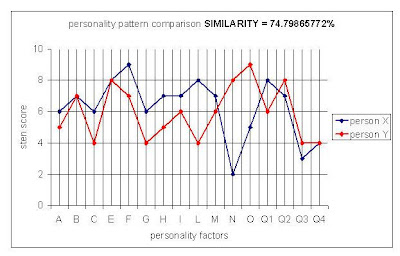
Here some examples
PERSONALITY PATTERN
Client #01 ---- 16PF5 Profile A:6.B:7.C:6.E:8.F:9.G:6.H:7.I:7.L:8.M:7.N:2.O:5.Q1:8.Q2:7.Q3:3.Q4:4
Client #02 ---- 16PF5 Profile A:5.B:7.C:4.E:8.F:7.G:4.H:5.I:6.L:4.M:6.N:8.O:9.Q1:6.Q2:8.Q3:4.Q4:4
Client #03 ---- 16PF5 Profile A:2.B:5.C:4.E:6.F:3.G:8.H:7.I:6.L:3.M:9.N:9.O:8.Q1:2.Q2:5.Q3:5.Q4:6
Client #04 ---- 16PF5 Profile A:7.B:7.C:6.E:8.F:8.G:7.H:6.I:5.L:8.M:7.N:4.O:5.Q1:7.Q2:7.Q3:3.Q4:4
Client #05 ---- 16PF5 Profile A:4.B:9.C:5.E:4.F:1.G:3.H:4.I:9.L:7.M:8.N:7.O:5.Q1:6.Q2:7.Q3:9.Q4:10
Client #06 ---- 16PF5 Profile A:8.B:6.C:3.E:5.F:2.G:9.H:6.I:9.L:3.M:6.N:7.O:5.Q1:5.Q2:7.Q3:7.Q4:4
Client #07 ---- 16PF5 Profile A:5.B:7.C:6.E:4.F:6.G:7.H:3.I:5.L:8.M:5.N:4.O:6.Q1:7.Q2:1.Q3:6.Q4:6
Client #08 ---- 16PF5 Profile A:9.B:8.C:5.E:7.F:5.G:6.H:8.I:2.L:6.M:4.N:8.O:7.Q1:6.Q2:5.Q3:5.Q4:9
Comparison data base for 8 clients, needs [8 * (8-1)] / 2 = 28 comparisons
(#01/CQ/#02) == K01 (6/CQ/5) + K02 (7/CQ/7) + K03 (6/CQ/4) + K04 (8/CQ/8) + K05 (9/CQ/7) + K06 (6/CQ/4) + K07 (7/CQ/5) + K08 (7/CQ/6) + K09 (8/CQ/4) + K10 (7/CQ/6) + K11 (2/CQ/8) + K12 (5/CQ/9) + K13 (8/CQ/6) + K14 (7/CQ/8) + K15 (3/CQ/4) + K16 (4/CQ/4) == 74.79865772% PROBABILITY OF BEING COMPATIBLE
(#02/CQ/#01) == (#01/CQ/#02) == 74.79865772%
and so on for the rest (27 comparisons)
(#01/CQ/#02) == #01 to #02 == 74.79865772%
// #02 to #01 == 74.79865772%
#01 to #03 == 54.09395973% // #02 to #03 == 63.59060403%
#01 to #04 == 92.55033557% // #02 to #04 == 75.26845638%
#01 to #05 == 57.71812081% // #02 to #05 == 61.00671141%
#01 to #06 == 59.73154362% // #02 to #06 == 65.90604027%
#01 to #07 == 68.99328859% // #02 to #07 == 64.49664430%
#01 to #08 == 62.75167785% // #02 to #08 == 66.34228188%
#03 to #01 == 54.09395973% // #04 to #01 == 92.55033557%
#03 to #02 == 63.59060403% // #04 to #02 == 75.26845638%
#03 to #04 == 54.89932886% // #04 to #03 == 54.89932886%
#03 to #05 == 49.49664430% // #04 to #05 == 56.54362416%
#03 to #06 == 67.34899329% // #04 to #06 == 64.42953020%
#03 to #07 == 53.99328859% // #04 to #07 == 73.32214765%
#03 to #08 == 61.20805369% // #04 to #08 == 66.54362416%
#05 to #01 == 57.71812081% // #06 to #01 == 59.73154362%
#05 to #02 == 61.00671141% // #06 to #02 == 65.90604027%
#05 to #03 == 49.49664430% // #06 to #03 == 67.34899329%
#05 to #04 == 56.54362416% // #06 to #04 == 64.42953020%
#05 to #06 == 62.18120805% // #06 to #05 == 62.18120805%
#05 to #07 == 62.98657718% // #06 to #07 == 57.85234899%
#05 to #08 == 59.02684564% // #06 to #08 == 60.43624161%
#07 to #01 == 68.99328859% // #08 to #01 == 62.75167785%
#07 to #02 == 64.49664430% // #08 to #02 == 66.34228188%
#07 to #03 == 53.99328859% // #08 to #03 == 61.20805369%
#07 to #04 == 73.32214765% // #08 to #04 == 66.54362416%
#07 to #05 == 62.98657718% // #08 to #05 == 59.02684564%
#07 to #06 == 57.85234899% // #08 to #06 == 60.43624161%
#07 to #08 == 61.87919463% // #08 to #07 == 61.87919463%
More examples:
The pattern 6.7.6.8.9.6.7.7.8.7.2.5.8.7.3.4
is 74.79865772% +/- 0.00000001%
similar to
5.7.4.8.7.4.5.6.4.6.8.9.6.8.4.4
The pattern 6.7.6.8.9.6.7.7.8.7.2.5.8.7.3.4
is 92.55033557% +/- 0.00000001%
similar to
7.7.6.8.8.7.6.5.8.7.4.5.7.7.3.4
The pattern 6.7.6.8.9.6.7.7.8.7.2.5.8.7.3.4
is 88.38926174% +/- 0.00000001%
similar to
5.6.4.7.7.5.6.6.7.6.3.4.7.6.2.3
The pattern 6.7.6.8.9.6.7.7.8.7.2.5.8.7.3.4
is 87.58389262% +/- 0.00000001%
similar to
7.8.6.9.9.7.8.8.9.8.5.6.9.8.4.5
The pattern 6.7.5.8.8.6.7.7.8.7.4.5.8.7.3.4
is 60.23489933% +/- 0.00000001%
similar to
8.9.7.10.10.8.9.9.10.9.6.7.10.9.5.6
The pattern 6.7.5.8.8.6.7.7.8.7.4.5.8.7.3.4
is 68.15436242% +/- 0.00000001%
similar to
4.3.7.8.5.4.7.8.7.7.6.8.8.5.7.6
The pattern 6.7.6.7.6.7.6.7.6.7.6.7.6.7.6.7
is 63.75838900% +/- 0.00000001%
similar to
4.5.4.5.4.5.4.5.4.5.4.5.4.5.4.5
The pattern 6.7.6.7.6.7.6.7.6.7.6.7.6.7.6.7
is 41.61073800% +/- 0.00000001%
similar to
3.4.3.4.3.4.3.4.3.4.3.4.3.4.3.4
The pattern 6.7.6.7.6.7.6.7.6.7.6.7.6.7.6.7
is 88.59060403% +/- 0.00000001%
similar to
7.8.7.8.7.8.7.8.7.8.7.8.7.8.7.8
High precision in matching algorithms is precisely the key to open the door and leave the infancy of compatibility testing.
It is all about achieving the eighth decimal!
With 8 decimals, you have more precision than any person could achieve by searching on one's own, but
the only way to achieve the eighth decimal is using analysis and correlation with quantized patterns.
High Precision patterns comparison between prospects SHOULD specify:
1) the ENSEMBLE (the whole set of different valid possibilities)
2) how exactly the compatibility matching method works, specifying main matching equation/ formula (without revealing proprietary information).
3) Which is the average number of "compatible real persons" for one person over the entire database? E.g.: 3 persons in a 100,000 persons database or 12 in 1,000,000. (or the 3 most compatible in 100,000 or the 12 most compatible in 1,000,000).
4) The whole precision
E.g.: "The pattern 6.7.6.8.9.6.7.7.8.7.2.5.8.7.3.4
is 92.55033557% +/- 0.00000001%
similar to the pattern 7.7.6.8.8.7.6.5.8.7.4.5.7.7.3.4"


